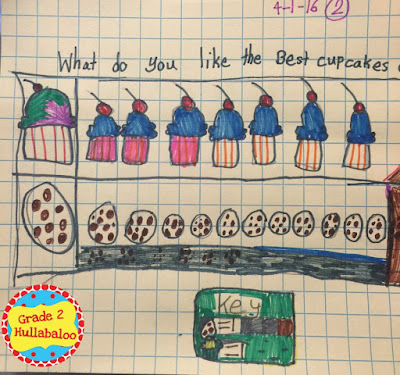Spring break is in my rear view mirror, and I am looking at the light at the end of the tunnel in terms of the end of school. We have thirty-two days of school left! My summer-loving, travel-loving self is filling with glee with each passing day. However, my teacher self is thinking, "I have so much left to do with this class!" I have the most amazing class of sweet children!
In these last six weeks of school, I want to make sure my second graders are ready for third grade in terms of writing, reading for deeper meaning, and being self-aware of their learning progress, AKA meta cognition if you want to use fancy language.
In the spirit of meta cognition, this past week, I focused on helping my students give written academic feedback to one another's picture graphs. Does this one make you want a cupcake or cookie? Me, too!
I have always invited students to give "celebrations" or suggestions on their classmates' writing or other work, but I took it one step further and had them write it on sticky notes. Read on for how I conducted this activity in my math lesson.
This week's focus, in math, was interpreting and creating graphs. After reviewing vocabulary, graphs, what they represent, and attention to the importance of a graph's key, the children began surveying. We created picture graphs together and watched the BrainPop, Jr. video on pictographs prior to starting independent graphs, so they were armed with the foundational skills. Here's a walk-through of what the students did:
First, the students and I brainstormed a list of important things to include in their picture graphs. I typed the list as they dictated it to me. I projected it on our ACTIV Board for reference during the activities. The children's list of important things to remember included:
- Pictures
- Line up pictures
- Colorful
- Title
- Legible and Neat
- Key
- Name
- Accurate (my pictures match my total number of tally marks)
With clear expectations in mind, and clipboards and lined sticky notes in hand, the children began conducting their surveys.
After surveying and tallying, the children began working on their graphs. I love some of the questions they used. You can tell who likes sweets, sports and books, can't you? Student choice is important, and this activity promotes it. Instant engagement!
|
|
| I love that the Percy Jackson versus Warriors graph includes a brief overview of the books! |
Once the graphs were complete, I put on some walking music (the kids wanted Monster Mash -- go figure!). Each child put a sticky note beside his graph. Students walked from desk to desk and wrote brief messages of suggestions or celebrations. The children were so involved and serious about this part of the lesson! It took some time, but it was better than any feedback I could have given. Peer feedback is a powerful tool to use, and I am so happy with the outcome. Note: I did participate, also. I made a point to give feedback to every child, as they still want their teacher's approval.
 |
| Clearly, this friend needs some feedback about his legibility. |
 |
| I love the approximated spelling of spectacular! |
We're tackling bar graphs next week. I'll use the same process, but with reminders to provide more detailed feedback. I can't wait to see what they create!
Have you used written feedback with your students? Is this something you'd like to try? I'd love to hear from you!









No comments: